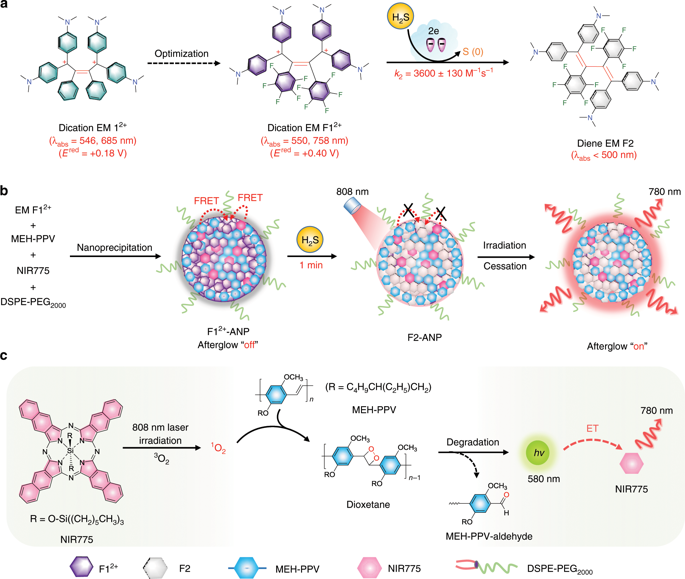当前位置:
X-MOL 学术
›
Nat. Commun.
›
论文详情
Our official English website, www.x-mol.net, welcomes your
feedback! (Note: you will need to create a separate account there.)
H2S-activatable near-infrared afterglow luminescent probes for sensitive molecular imaging in vivo.
Nature Communications ( IF 14.7 ) Pub Date : 2020-01-23 , DOI: 10.1038/s41467-020-14307-y Luyan Wu 1 , Yusuke Ishigaki 2 , Yuxuan Hu 1 , Keisuke Sugimoto 2 , Wenhui Zeng 1 , Takashi Harimoto 2 , Yidan Sun 1 , Jian He 3 , Takanori Suzuki 2 , Xiqun Jiang 4 , Hong-Yuan Chen 1 , Deju Ye 1, 5
Nature Communications ( IF 14.7 ) Pub Date : 2020-01-23 , DOI: 10.1038/s41467-020-14307-y Luyan Wu 1 , Yusuke Ishigaki 2 , Yuxuan Hu 1 , Keisuke Sugimoto 2 , Wenhui Zeng 1 , Takashi Harimoto 2 , Yidan Sun 1 , Jian He 3 , Takanori Suzuki 2 , Xiqun Jiang 4 , Hong-Yuan Chen 1 , Deju Ye 1, 5
Affiliation

|
Afterglow luminescent probes with high signal-to-background ratio show promise for in vivo imaging; however, such probes that can be selectively delivered into target sites and switch on afterglow luminescence remain limited. We optimize an organic electrochromic material and integrate it into near-infrared (NIR) photosensitizer (silicon 2,3-naphthalocyanine bis(trihexylsilyloxide) and (poly[2-methoxy-5-(2-ethylhexyloxy)-1,4-phenylenevinylene]) containing nanoparticles, developing an H2S-activatable NIR afterglow probe (F12+-ANP). F12+-ANP displays a fast reaction rate (1563 ± 141 M-1 s-1) and large afterglow turn-on ratio (~122-fold) toward H2S, enabling high-sensitivity and -specificity measurement of H2S concentration in bloods from healthy persons, hepatic or colorectal cancer patients. We further construct a hepatic-tumor-targeting and H2S-activatable afterglow probe (F12+-ANP-Gal) for noninvasive, real-time imaging of tiny subcutaneous HepG2 tumors (<3 mm in diameter) and orthotopic liver tumors in mice. Strikingly, F12+-ANP-Gal accurately delineates tumor margins in excised hepatic cancer specimens, which may facilitate intraoperative guidance of hepatic cancer surgery.
中文翻译:

H2S 可激活的近红外余辉发光探针,用于体内灵敏的分子成像。
具有高信号背景比的余辉发光探针显示出体内成像的前景;然而,这种可以选择性递送到目标位点并打开余辉发光的探针仍然有限。我们优化了一种有机电致变色材料,并将其集成到近红外(NIR)光敏剂(硅2,3-萘酞菁双(三己基甲硅烷基氧化物)和(聚[2-甲氧基-5-(2-乙基己氧基)-1,4-亚苯基亚乙烯基])中)含有纳米颗粒,开发了一种可 H2S 激活的近红外余辉探针(F12+-ANP),具有快速反应速率(1563 ± 141 M-1 s-1)和大余辉开启比(~122 倍)。我们进一步构建了一种用于非侵入性的肝肿瘤靶向和 H2S 激活余辉探针(F12+-ANP-Gal)。 ,对小鼠微小皮下 HepG2 肿瘤(直径 <3 毫米)和原位肝脏肿瘤进行实时成像,引人注目的是,F12+-ANP-Gal 可以准确地勾画出肝癌切除标本中的肿瘤边缘,这可能有助于肝癌手术的术中指导。 。
更新日期:2020-01-23
中文翻译:

H2S 可激活的近红外余辉发光探针,用于体内灵敏的分子成像。
具有高信号背景比的余辉发光探针显示出体内成像的前景;然而,这种可以选择性递送到目标位点并打开余辉发光的探针仍然有限。我们优化了一种有机电致变色材料,并将其集成到近红外(NIR)光敏剂(硅2,3-萘酞菁双(三己基甲硅烷基氧化物)和(聚[2-甲氧基-5-(2-乙基己氧基)-1,4-亚苯基亚乙烯基])中)含有纳米颗粒,开发了一种可 H2S 激活的近红外余辉探针(F12+-ANP),具有快速反应速率(1563 ± 141 M-1 s-1)和大余辉开启比(~122 倍)。我们进一步构建了一种用于非侵入性的肝肿瘤靶向和 H2S 激活余辉探针(F12+-ANP-Gal)。 ,对小鼠微小皮下 HepG2 肿瘤(直径 <3 毫米)和原位肝脏肿瘤进行实时成像,引人注目的是,F12+-ANP-Gal 可以准确地勾画出肝癌切除标本中的肿瘤边缘,这可能有助于肝癌手术的术中指导。 。


















































 京公网安备 11010802027423号
京公网安备 11010802027423号